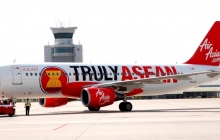AirAsia was launched in 2001 with the dream of making flying possible for everyone. Since then, AirAsia has swiftly risen to become the world’s best...
-

Healthcare
Where to invest?
Healthcare
ASEAN’s evolving demographics and lifestyle is driving changes in the healthcare sector. Life longevity in Southeast Asia is expected to exceed other areas in Asia in the long term, challenging healthcare providers to equip themselves with skills and resources in caring for elderly people. As communicable diseases have successfully been placed under control and infant mortality ratio improves, focus in many ASEAN countries has shifted to treating chronic diseases and injuries which are top death causes.
Stress is getting widely recognized as a serious and costly issue such that more people are keeping themselves as healthy as possible to combat it. Individuals strive to prioritize overall wellness for productivity and quality of life. Attention is gearing towards healthcare prevention rather than illness cure.
Economic growth has stirred greater demand for quality and innovative healthcare services. Increasing disposable income of ASEAN market allows people to avail themselves of higher-value products and services. Today, a visit to a medical facility does not necessarily spell bad news. Healthcare services have expanded to elective treatments and aesthetic surgery, assisted reproductive technologies, sports skills rehabilitation, and weight loss centres, among others.
Healthcare spending
World Health Organization data estimates that average total healthcare expenditure per capita in ASEAN is US$ 544, about 4 percent of GDP. Singapore and Brunei top the list with expenditure per capita of US$ 2,273 and US$ 1,449, respectively. ASEAN is expected to boost health spending in order to provide better healthcare services and catch up with the average spending rate in fully developed countries.
In Singapore where ageing population rises, plans to add 3,700 hospital beds and recruit 20,000 more healthcare workers were laid-out in the country’s Healthcare 2020 Masterplan. Malaysia increased by 15% its 2013 budget for healthcare to US$ 6.36 billion (RM 19.3 billion).
Private sector is pouring money. Bangkok Dusit Medical Services has invested in highly profitable non-core medical businesses. Makati Medical Centre, one of the leading hospitals in the Philippines, is investing in new laboratories to revolutionize diagnosis and treatment of diseases. Last year, Viet Nam unveiled VinMec, the country’s largest and first hotel-like hospital featuring five-star hotel standard, 25 VIP rooms, and two presidential suites.
Public private sector partnership (PPP) is also fast becoming an option in improving and expanding healthcare services. In the Philippines, the government opened for bidding the construction of a 700-bed capacity super specialty tertiary hospital. The project is estimated to cost US$ 135 million.
Parkway Pantai, one of Asia’a largest private healthcare providers, is in a joint venture with the Brunei Investment Agency in managing a 21-bed specialty cardiac centre. Integrated Healthcare Holding partnered with Singapore government in leasing capacity and services from private healthcare operators.
Medical tourism
Medical tourism steadily contributes to the increasing number of foreign patients in some of ASEAN’s world-class medical facilities. Thailand’s health tourism is worth about US$ 2 billion and receives 40% of medical tourist arrivals in Asia. Malaysia’s foreign patients, meanwhile, reached over 600,000 last year with revenue increasing to US$ 197.6 million from US$ 83.6 million in 2007.
The Philippines is hoping to catch some percentage of the millions of foreign patients travelling to Asia for medical reasons. It targets to attract 200,000 foreign patients annually. It has recently accredited 44 hospitals and health facilities for medical tourism.
-
The healthcare services sector is expected to continuously propel ASEAN’s growth and economic activity. ASEAN commits to liberalise healthcare and facilitate movement of medical, dental and other healthcare practitioners.
SUCCESS STORIES
-
- Site Map
- Terms & Abbreviations

